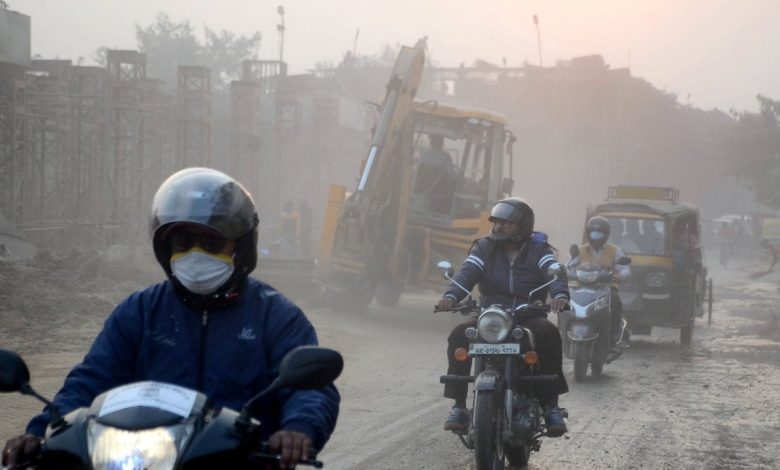Nagpur’s Air Quality Declines as Winter Begins, AQI Hits ‘Poor’ Levels

As the crisp winter air approaches Nagpur, it brings with it a troubling reality—deteriorating air quality. The city’s Air Quality Index (AQI) has consistently hit “Poor” levels, signaling the beginning of a season plagued by pollution. Over the past few days, AQI levels have soared, with multiple monitoring stations in the city reporting dangerous readings, exceeding 200. This article explores the factors contributing to this decline, the health impacts, and what measures can be taken to mitigate the situation.
Why is Nagpur’s Air Quality Declining?
Nagpur’s air quality declines dramatically as winter sets in, and the reasons are multifaceted. While the cooler weather may bring relief from summer’s heat, it also traps pollutants closer to the ground. The city’s topography and industrial activities play a significant role in amplifying the pollution levels.
The Onset of Winter and Its Effects on Air Quality
Winter weather, particularly in urban areas, often brings with it a rise in air pollution. This phenomenon is attributed to the way cold air traps pollutants, a process known as temperature inversion. During winter, the cool air in Nagpur sits beneath a layer of warmer air, preventing pollutants from dispersing into the upper atmosphere. This creates a concentration of harmful particles near the ground, which is especially evident during the mornings and evenings.
Temperature Inversion – The Key Culprit
Temperature inversion plays a critical role in worsening air quality during winter. It essentially forms a lid over the city, trapping pollutants such as vehicle emissions, industrial waste, and even dust particles, which would otherwise escape into the atmosphere. This results in rising AQI levels, especially in densely populated areas like Nagpur.
The AQI: What Does ‘Poor’ Mean?
The Air Quality Index (AQI) is a number used to communicate how polluted the air currently is or is forecasted to become. Nagpur’s AQI readings exceeding 200 signal “Poor” air quality. But what does this mean for the average citizen?
Health Implications of Poor AQI Levels
A “Poor” AQI reading, between 201 and 300, is unhealthy for sensitive groups, including children, the elderly, and individuals with respiratory or cardiovascular conditions. Prolonged exposure to such air can lead to significant health issues, including asthma attacks, lung infections, and even heart problems.
Sources of Air Pollution in Nagpur
Nagpur’s pollution is the result of several contributing factors. As winter intensifies, certain sources of pollution become more pronounced.
Vehicular Emissions – A Major Contributor
Nagpur’s growing population has led to an increase in the number of vehicles on the roads. Vehicular emissions are a significant source of particulate matter (PM), nitrogen dioxide (NO2), and other harmful gases that exacerbate air pollution.
Industrial Pollution and Dust Accumulation
The industrial sector in and around Nagpur plays a huge role in pollution levels. Factories emit a range of pollutants that add to the PM2.5 and PM10 levels, particles that are particularly dangerous to human health. Additionally, construction activities and unpaved roads contribute to dust pollution, worsening air quality.
Garbage Burning and Household Chulhas
During winter, many households resort to burning garbage and using traditional chulhas for warmth and cooking, releasing harmful pollutants like carbon monoxide (CO) and fine particulate matter (PM2.5), which are especially dangerous in poorly ventilated spaces.
Continuous Ambient Air Quality Monitoring Stations (CAAQMS)
Nagpur has four Continuous Ambient Air Quality Monitoring Stations (CAAQMS) that regularly record and monitor AQI levels across the city. Unfortunately, real-time data from these stations has not been available to the public for several days, adding to the concern.
The Highest AQI Levels Recorded
The highest AQI was recorded at Town Hall in Mahal, where levels reached 216. Other stations in Ram Nagar, Ambazari, and the Government Post Office (GPO) also showed worrying trends with AQI readings between 192 and 210.
Effects of Air Pollution on Daily Life
Poor air quality doesn’t just affect your health—it can significantly impact daily activities as well. From limiting outdoor exercise to increasing healthcare visits, the consequences of bad air go beyond physical ailments.
Limiting Outdoor Activities
As the air quality worsens, it is advised to limit outdoor activities, particularly for vulnerable populations like children, the elderly, and those with pre-existing health conditions. Schools may need to adjust their schedules, and citizens are often urged to stay indoors when AQI levels are especially high.
Indoor Air Quality Concerns
It’s not just the outdoor air that poses a threat. Indoor pollution from cooking, smoking, and even household cleaners can add to the overall burden of pollutants in the air. In homes without proper ventilation, this can lead to a buildup of harmful substances.
What Can Be Done to Improve Air Quality in Nagpur?
While the situation may seem bleak, there are steps both citizens and the government can take to improve Nagpur’s air quality. These measures range from reducing emissions to increasing public awareness about the importance of clean air.
Government Initiatives
The Maharashtra Pollution Control Board (MPCB) has implemented the National Clean Air Programme (NCAP) to address pollution levels. These efforts include the installation of more air monitoring stations, stricter regulations on industries, and initiatives to reduce vehicular emissions.
Individual Responsibility
Citizens can also play a role in reducing air pollution. Simple measures like carpooling, using public transportation, and avoiding the burning of garbage can make a big difference. Additionally, installing air purifiers and regularly checking AQI levels can help safeguard health during periods of poor air quality.
Looking Ahead: The Future of Air Quality in Nagpur
While the immediate outlook for Nagpur’s air quality might not be optimistic, long-term solutions are being considered. By combining stricter regulations, technological advancements, and public participation, the city can gradually improve its air quality and protect its citizens from the health risks associated with pollution.
Nagpur’s declining air quality is a serious concern as winter approaches, bringing with it a rise in AQI levels and associated health risks. While the causes of pollution are clear—ranging from vehicular emissions to industrial activity—addressing the issue requires a collective effort. From government initiatives like the NCAP to individual actions, there are steps that can be taken to reverse the trend. Citizens must remain vigilant, stay informed about AQI levels, and take necessary precautions to protect their health.
- What is the Air Quality Index (AQI)?
- The AQI is a measure of air quality, with levels above 200 indicating “Poor” conditions that can negatively impact health.
- Why does air quality worsen in winter?
- Winter leads to temperature inversion, which traps pollutants close to the ground, making the air quality worse.
- What are the main sources of pollution in Nagpur?
- Vehicular emissions, industrial activities, garbage burning, and household chulhas are significant contributors to pollution.
- How can individuals reduce their exposure to polluted air?
- By staying indoors during high AQI periods, using air purifiers, and avoiding outdoor exercise when pollution levels are high.
- What steps can the government take to improve air quality?
- Implementing stricter regulations on industries, promoting clean energy, and increasing public awareness about the dangers of pollution.









